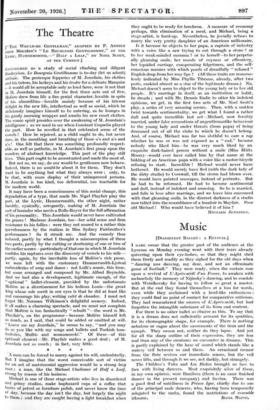Music
[DIAGHILEFF BALLET : A REVIVAL.]
I DARE swear that the greater part of the audience at the Lyceum on Monday evening went with their tears already quivering upon their eye-lashes, so that they might shed them freely and readily as they sighed for the old days when " dancing was dancing, my dear, and not an effeminate game of football." They were ready, when the curtain rose upon a revival of L'Apres-midi dun Fauns, to awaken with melancholy the memory of Nijinsky's dancing, and to condole with Woizikovsky for having to follow so great a master. But at the end they found themselves at a loss for words, even while they acclaimed with a herd-like enthusiasm : they could find no point of contact for comparative criticism. They had remembered the success of L'Apres-midi, but had forgotten the intangible substance of its form and content.
For there is no other ballet so elusive as this. To say that it is a dream does not sufficiently account for its qualities, for its choreographic shape, for example. There is nothing nebulous or vague about the movements of the faun and the nymph. They swoon not, neither do they lapse. And yet for all the sharp outline of their expression, they are less real than any of the creatures we encounter in dreams. This is partly explained by the haze of sound which stands like a watery veil between us and them. An occasional tremor from the flute revives our immediate senses, but the veil never lifts, and through it we see, not darkly, but strangely.
The Children's Tales and Les Biches brought us face to face with living dancers. Most exquisitely alive of these, in my own opinion, were Danilova (there is no more finished dancer in the present company) and Savina. There was a good deal of untidiness in Prince Agar, chiefly due to one of the principal male dancers, -who, having been temporarily relegated to the ranks, found the restrictions of ensemble






























































 Previous page
Previous page